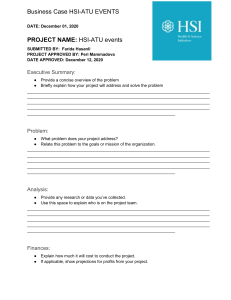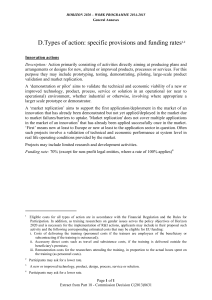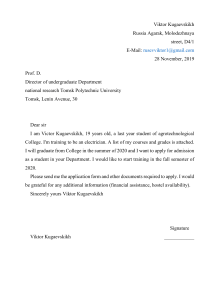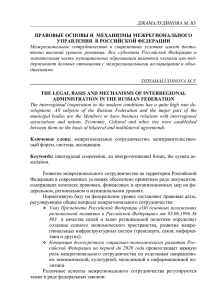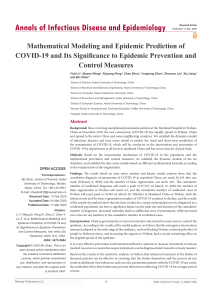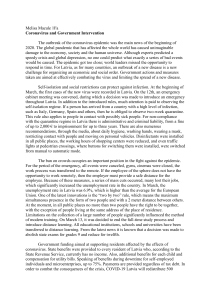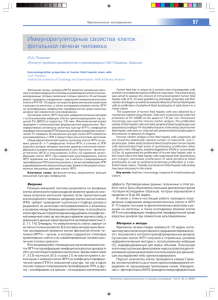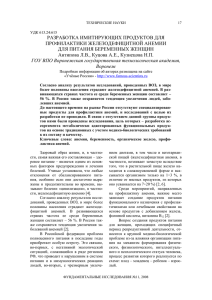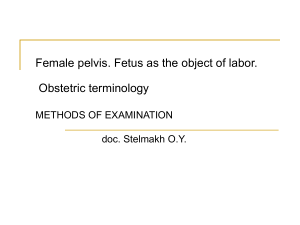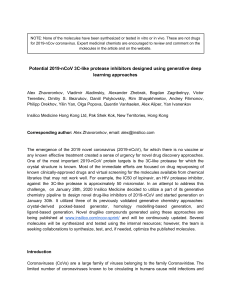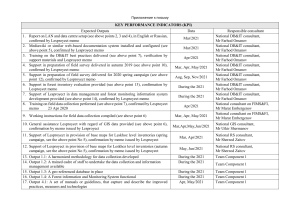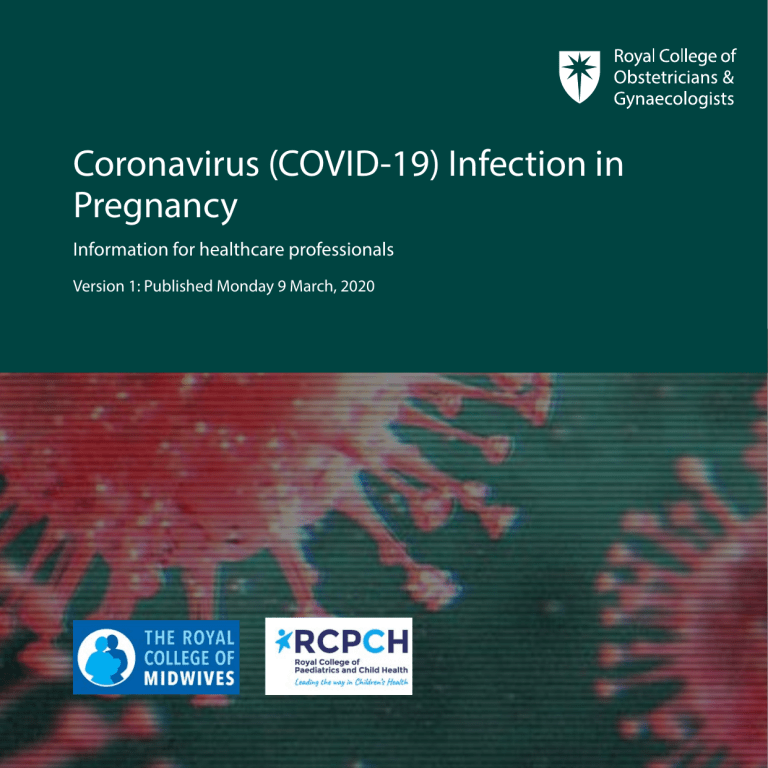
Coronavirus (COVID-19) Infection in Pregnancy Information for healthcare professionals Version 1: Published Monday 9 March, 2020 1 Table of contents Introduction 3-5 Advice for health professionals to share with pregnant women 7-9 Advice for services caring for women with suspected or confirmed COVID-19 11-23 Advice for services caring for women following recovery from confirmed COVID-19 25 Acknowledgements 26 Flow chart to assess COVID-19 risk in maternity unit attendees 27-28 References 30-31 2 1. Introduction The following advice is provided as a resource for UK Healthcare Professionals based on a combination of available evidence, good practice and expert advice. The priorities are the provision of safe care to women with suspected/confirmed COVID-19 and the reduction of onward transmission. Please be aware that this is very much an evolving situation and this guidance is a living document that may be updated if or when new information becomes available. We therefore suggest that you visit this page regularly for updates. This guidance will be kept under regular review as new evidence emerges. If you would like to suggest additional areas for this guidance to cover, any clarifications required or to submit new evidence for consideration, please email COVID-19@rcog.org.uk. Please note, we will not be able to give individual clinical advice or information for specific organisational requirements via this email address. 1.1 The virus Novel coronavirus (SARS-COV-2) is a new strain of coronavirus causing COVID-19, first identified in Wuhan City, China. Other coronavirus infections include the common cold (HCoV 229E, NL63, OC43 and HKU1), Middle East Respiratory Syndrome (MERS-CoV) and Severe Acute Respiratory Syndrome (SARS-CoV). 1.2 Epidemiology The virus appears to have originated in Hubei Province in China towards the end of 2019. Since then China has remained the country with the highest number of infected individuals. Within Europe, Italy is the country currently most affected. This situation is naturally changing rapidly and for the most up to date advice please consult local Health Protection advice. Health Protection is a devolved matter and links to local guidance are available for England, Wales, Scotland and Northern Ireland. Public Health England (PHE) and Health Protection Scotland (HPS) have been cited throughout this document; specific guidance from the other areas of the United Kingdom will be updated as they become available. 3 Pregnant women do not appear to be more susceptible to the consequences of infection with COVID-19 than the general population. Data are limited but special consideration should be given to pregnant women with concomitant medical illnesses who could be infected with COVID-19 until the evidence base provides clearer information. There are no reported deaths in pregnant women at the moment. 1.3 Transmission Most cases of COVID-19 globally have evidence of human to human transmission. However, recent cases have appeared where there is no evidence of contact with infected people. This virus appears to spread readily, through respiratory, fomite or faecal methods. Healthcare providers are recommended to employ strict infection prevention and control (IPC) measures; guidance is available as per local Health Protection guidance. Only one case of possible vertical transmission (transmission from mother to baby antenatally or intrapartum) has been reported in the literature.1 Expert opinion is that the fetus is unlikely to be exposed during pregnancy. A case series published by Chen et al tested amniotic fluid, cord blood, neonatal throat swabs and breastmilk samples from COVID-19 infected mothers and all samples tested negative for the virus.2 Furthermore, in a different paper by Chen et al, three placentas of infected mothers were swabbed and tested negative for the virus.3 Transmission is therefore most likely to be as a neonate. There is currently no evidence concerning transmission through genital fluids. The management of the neonate during early bonding and feeding are discussed below in Section 3.8. 1.4 Effect on the mother/symptoms The large majority of women will experience only mild or moderate cold/flu like symptoms. Cough, fever and shortness of breath are other relevant symptoms. More severe symptoms such as pneumonia and marked hypoxia are widely described with COVID-19 in older people, the immunosuppressed and those with long-term conditions such as diabetes, cancer and chronic lung disease. These symptoms could occur in pregnant women so should be identified and treated promptly. At present there is one reported case of a woman with COVID-19 who required mechanical ventilation at 30 weeks’ gestation, following which she had an emergency caesarean section and made a good recovery.4 Within the general population there is evolving evidence that there could be a cohort of asymptomatic individuals or those with very minor symptoms that are carrying the virus, although the incidence is unknown. 4 1.5 Effect on the fetus There are currently no data suggesting an increased risk of miscarriage or early pregnancy loss in relation to COVID-19. Case reports from early pregnancy studies with SARS and MERS do not demonstrate a convincing relationship between infection and increased risk of miscarriage or second trimester loss.5 As there is no evidence of intrauterine fetal infection with COVID-19 it is therefore currently considered unlikely that there will be congenital effects of the virus on fetal development. There are case reports of preterm birth in women with COVID-19, but it is unclear whether the preterm birth was always iatrogenic, or whether some were spontaneous. Iatrogenic delivery was predominantly for maternal indications related to the viral infection, although there was evidence of fetal compromise and prelabour premature rupture of membrane, in at least one report.2 5 Advice for health professionals to share with pregnant women 6 2. Advice for health professionals to share with pregnant women 2.1 Travel advice for pregnant women The Foreign and Commonwealth Office (FCO) in the UK offers advice about travel safety that is regularly updated in line with the evolving situation. Pregnant women in the UK should follow the advice given by the FCO on the UK Government website.6 All individuals, including pregnant women, should ensure that they have adequate insurance arrangements prior to travel. Finally, pregnant women should check that their travel insurance will provide cover for birth and care of a newborn baby if they give birth while abroad. 2.2 General advice for pregnant women who may have been exposed to COVID-19 or are experiencing symptoms suggestive of COVID-19 Pregnant women concerned about exposure or symptoms indicating possible infection with COVID-19 in England, Wales or Northern Ireland should call NHS 111 or use the NHS’s 111 tool.6 In Scotland they should call their GP or NHS 24 (on 111) or visit NHS Inform for further advice. They should not visit their GP practice or attend A&E in person. If it is an emergency they should phone 999 and tell the operator of possible COVID-19 exposure. Women returning from areas of the world which indicate a possible increased risk for coronavirus transmission (list for England, Wales and Northern Ireland; list for Scotland) or who have been in contact with a known case of COVID-19 should phone NHS 111 or, if in Scotland, NHS 24 (on 111) or their GP. Diagnostic swabs will be arranged if indicated, following advice from local Health Protection. Women with symptoms suggestive of COVID-19 should be advised to self-isolate until advised otherwise. Advice on self-isolation for mild confirmed cases is still being developed. 7 2.3 Advice regarding self-isolation for women with possible or confirmed Pregnant women who have been advised to self-isolate should stay indoors and avoid contact with others for 14 days. Public Health England currently provides guidance for: • People who are advised to self-isolate • People who live in the same accommodation as someone who is self-isolating For women who are advised to self-isolate, the guidance currently recommends to: • Not go to school, work, NHS settings or public areas • Not use public transport • Stay at home and not allow visitors • Ventilate the rooms where they are by opening a window • Separate themselves from other members of their household as far as possible, using their own towels, crockery and utensils and eating at different times • Use friends, family or delivery services to run errands, but advise them to leave items outside7 Women should be advised to contact their maternity care provider (e.g. midwife or antenatal clinic), to discuss attendance for routine antenatal appointments. See below for specific hospital guidance. Pregnant women who are due to attend routine maternity appointments in the UK should contact their maternity care provider, to inform them that they are currently in self-isolation for possible/confirmed COVID-19, and request advice on attendance. Pregnant women are advised not to attend maternity triage units or A&E unless in need of urgent obstetric or medical care. If women are concerned and require urgent medical advice, they are encouraged to call the maternity triage unit in the first instance. If attendance at the maternity unit or 8 hospital is advised, pregnant women are requested to travel by private transport and alert the maternity triage reception once on the premises, prior to entering the hospital. 2.4 Diagnosis of COVID-19 The process of COVID-19 diagnosis is changing rapidly. If diagnostic tests are advised, pregnant women should follow advice given, which should not be altered based on pregnancy status. In the UK, pregnant women should be investigated and diagnosed as per local / Public Health England8/Health Protection Scotland9 criteria. Obstetricians and midwives should liaise with their local virology service / health protection team for further details about arrangements for testing and notification reporting of a positive test result. 9 Advice for services caring for women with suspected or confirmed COVID-19 10 3. Advice for services caring for women with suspected or confirmed COVID-19 The following advice mostly refers to the care of women in the second or third trimesters of pregnancy. Care of women in the first trimester should include attention to the same infection prevention and investigation/diagnostic guidance, as for non-pregnant adults. 3.1 General advice for services providing care to women with suspected or confirmed COVID-19, in whom hospital attendance is necessary The following suggestions apply to all hospital/clinic attendances for women with suspected or confirmed COVID-19: • Women should be advised to attend via private transport where possible or call 111/999 for advice as appropriate. If an ambulance is required, the call handler should be informed that the woman is currently in self-isolation for possible COVID-19. • Women should be asked to alert a member of maternity staff to their attendance when on the hospital premises, but prior to entering the hospital • Staff providing care should take personal protective equipment (PPE) precautions as per local /Public Health England10/Health Protection Scotland9 guidance • Women should be met at the maternity unit entrance by staff wearing appropriate PPE and provided with a surgical face mask (not FFP3 mask). The face mask should not be removed until the woman is isolated in a suitable room. • Women should immediately be escorted to an isolation room, suitable for the majority of care during their hospital visit or stay o For overnight stays, isolation rooms should ideally have an ante-chamber for donning and removing staff PPE equipment and ensuite bathroom facilities 11 o Rooms should have negative pressure in comparison to the surrounding area, if available • Only essential staff should enter the room and visitors should be kept to a minimum • Remove non-essential items from the clinic/scan room prior to consultation • All clinical areas used will need to be cleaned after use as per local/Public Health England10/ Health Protection Scotland9 guidance • Women should immediately be escorted to an isolation room, suitable for the majority of care during their hospital visit or stay 3.2 Women presenting for care with unconfirmed COVID-19 but symptoms suggestive of possible infection Maternity departments with direct entry for patients and the public should have in place a system for identification of potential cases as soon as possible to prevent potential transmission to other patients and staff. This should be at first point of contact (either near the entrance or at reception) to ensure early recognition and infection control. This should be employed before a patient sits in the maternity waiting area. Services should follow guidance available from the NHS about whether the woman is at risk of COVID-19. If women meet the “epidemiological criteria” to be tested (at the time of writing, travel to an affected area or exposure to a known case) and show symptoms, they should be tested. Until test results are available, they should be treated as though they have confirmed COVID-19. The full Public Health England guidance8 has been summarised in a flowchart for this guideline (Appendix 1). Pregnant women may attend for pregnancy reasons and have coincidental symptoms meeting current COVID-19 case definition. There are some situations where overlap between pregnancy symptoms and COVID-19 symptoms may cause confusion (e.g. fever with ruptured membranes). In cases of uncertainty seek additional advice or in case of emergency treat as suspected COVID-19 until advice can be sought. 12 In the event of a pregnant woman attending with an obstetric emergency and being suspected or confirmed to have COVID-19, maternity staff must first follow IPC guidance. This includes transferring to an isolation room and donning appropriate PPE. This can be time consuming and stressful for patients and health professionals. Once IPC measures are in place the obstetric emergency should be dealt with as the priority. Do not delay obstetric management in order to test for COVID-19. Further care, in all cases, should continue as for a woman with confirmed COVID-19, until a negative test result is obtained. 3.3 Attendance for routine antenatal care in women with suspected or confirmed COVID-19 Routine appointments for women with suspected or confirmed COVID-19 (growth scans, OGTT, antenatal community or secondary care appointments) should be delayed until after the recommended period of isolation. Advice to attend more urgent pre-arranged appointments (fetal medicine surveillance, high risk maternal secondary care) will require a senior decision on urgency and potential risks/benefits. Trusts are advised to arrange local, robust communication pathways for senior maternity staff members to screen and coordinate appointments missed due to suspected or confirmed COVID-19. If it is deemed that obstetric or midwifery care cannot be delayed until after the recommended period of isolation, infection prevention and control measures should be arranged locally to facilitate care. Pregnant women in isolation who need to attend should be contacted by a local care coordinator to rebook urgent appointments / scans, preferably at the end of the working day. 3.4 Attendance for unscheduled/urgent antenatal care in women with suspected or confirmed COVID-19 Where possible, early pregnancy (EPU) or maternity triage units should provide advice over the phone. If this requires discussion with a senior member of staff who is not immediately available, a return telephone call should be arranged. 13 Local protocols are required to ensure women with confirmed or suspected COVID-19 are isolated on arrival to EPU or triage units and full PPE measures are in place for staff (see Section 3.1). Medical, midwifery or obstetric care should otherwise be provided as per routine. 3.5 Women who develop new symptoms during admission (antenatal, intrapartum or postnatal) There is an estimated incubation period of 0-14 days (mean 5-6 days); an infected woman may therefore present asymptomatically, developing symptoms later during an admission.11 Health professionals should be aware of this possibility, particularly those who regularly measure patient vital signs (e.g. Health Care Assistants). Local guidance should be available on whom to contact for further assessment of the patient in the event of new onset respiratory symptoms or unexplained fever. 3.6 Women attending for intrapartum care with suspected/confirmed COVID-19 and no/mild symptoms 3.6.1 Attendance in labour All women should be encouraged to call the maternity unit for advice in early labour. Women with mild COVID-19 symptoms can be encouraged to remain at home (self-isolating) in early (latent phase) labour as per standard practice. If birth at home or in a midwifery-led unit is planned, a discussion should be initiated with the woman regarding the potentially increased risk of fetal compromise in women infected with COVID-19 (as was noted in the Chinese case series of nine women).2 The woman should be advised to attend an obstetric unit for birth, where the baby can be monitored using continuous electronic fetal monitoring. This guidance may change as more evidence becomes available. When a woman decides to attend the maternity unit, general recommendations about hospital attendance (Section 3.1) apply. 14 Once settled in an isolation room, a full maternal and fetal assessment should be conducted to include: • Assessment of the severity of COVID-19 symptoms should follow a multi-disciplinary team approach including an infectious diseases or medical specialist • Maternal observations including temperature, respiratory rate and oxygen saturations • Confirmation of the onset of labour, as per standard care • Electronic fetal monitoring using cardiotocograph (CTG) o In two Chinese case series, including a total of 18 pregnant women infected with COVID-19 and 19 babies (one set of twins), there were 8 reported cases of fetal compromise.212 Given this relatively high rate of fetal compromise, continuous electronic fetal monitoring in labour is currently recommended for all women with COVID-19. • If the woman has signs of sepsis, investigate and treat as per RCOG guidance on sepsis in pregnancy, but also consider active COVID-19 as a cause of sepsis and investigate according to guidance If there are no concerns regarding the condition of either the mother or baby, women who would usually be advised to return home until labour is more established, can still be advised to do so, if appropriate transport is available. Women should be given the usual advice regarding signs and symptoms to look out for, but in addition should be told about symptoms that might suggest deterioration related to COVID-19 following consultation with the medical team (e.g. difficulty in breathing, fever greater than 38.0oC). If labour is confirmed, then care in labour should ideally continue in the same isolation room. 3.6.2 Care in labour The following considerations apply to women in spontaneous or induced labour: • 15 When a woman with COVID-19 is admitted to the Delivery Suite, the following members of the multi-disciplinary team should be informed: consultant obstetrician, consultant anaesthetist, midwife-in-charge, consultant neonatologist and neonatal nurse in charge • Efforts should be made to minimise the number of staff members entering the room and units should develop a local policy specifying essential personnel for emergency scenarios • Maternal observations and assessment should be continued as per standard practice, with the addition of hourly oxygen saturations o Aim to keep oxygen saturation >94%, titrating oxygen therapy accordingly • If the woman has signs of sepsis, investigate and treat as per RCOG guidance on sepsis in pregnancy, but also consider active COVID-19 as a cause of sepsis and investigate according to guidance • Given the rate of fetal compromise reported in the Chinese case series,2 12 the current recommendation is for continuous electronic fetal monitoring in labour. This recommendation may be altered as more evidence becomes available. • There is currently no evidence to favour one mode of birth over another and therefore mode of birth should be discussed with the woman, taking into consideration her preferences and any obstetric indications for intervention. Mode of birth should not be influenced by the presence of COVID-19, unless the woman’s respiratory condition demands urgent delivery. o At present, there are no recorded cases of vaginal secretions being tested for COVID-19. However, a stool sample from a male patient with diarrhoea in the USA did test positive for the virus13 • There is no evidence that epidural or spinal analgesia or anaesthesia is contraindicated in the presence of coronaviruses. Epidural analgesia should therefore be recommended before, or early in labour, to women with suspected/confirmed COVID-19 to minimise the need for general anaesthesia if urgent delivery is needed, and because there is a risk that use of Entonox may increase aerosolisation and spread of the virus. • If Entonox is used then the breathing system must contain a filter to prevent contamination with the virus (< 0.05µm pore size 16 • In case of deterioration in the woman’s symptoms, refer to Section 3.7 for additional considerations, and make an individual assessment regarding the risks and benefits of continuing the labour, versus proceeding to emergency caesarean birth if this is likely to assist efforts to resuscitate the mother. • When caesarean birth or other operative procedure is advised, follow guidance from Section 3.6.4 o For Category 1 CS, donning PPE is time consuming. This may impact on the decision to delivery interval but it must be done. Women and their families should be told about this possible delay. • An individualised decision should be made regarding shortening the length of the second stage of labour with elective instrumental birth in a symptomatic woman who is becoming exhausted or hypoxic • Given a lack of evidence to the contrary, delayed cord clamping is still recommended following birth, provided there are no other contraindications. The baby can be cleaned and dried as normal, while the cord is still intact. 3.6.3 General advice for obstetric theatre 17 • Elective procedures should be scheduled at the end of the operating list • Non-elective procedures should be carried out in a second obstetric theatre, where available, allowing time for a full post-operative theatre clean according to local/Public Health England /Health Protection Scotland guidance14 10 • The number of staff in the operating theatre should be kept to a minimum, all of whom must wear appropriate PPE • All staff (including maternity, neonatal and domestic) should have been trained in the use of PPE so that 24 hour emergency theatre use is available and possible delays reduced 3.6.4 Elective caesarean birth Where women with symptomatic COVID-19 have scheduled appointments for pre-operative care and elective caesarean birth, an individual assessment should be made to determine whether it is safe to delay the appointment to minimise the risk of infectious transmission to other women, healthcare workers and, postnatally, to her infant. In cases where elective caesarean birth cannot safely be delayed, the general advice for services providing care to women admitted when affected by suspected/confirmed COVID-19 should be followed (see Section 3.1). Obstetric management of elective caesarean birth should be according to usual practice. Anaesthetic management for symptomatic women should be to: • Provide epidural or spinal anaesthesia as required and to avoid general anaesthesia unless absolutely necessary • If general anaesthesia is needed, either for pre-existent reasons such as coagulopathy, because of urgency or because of the mother’s medical condition, the advice is as follows: o Use of PPE causes communication difficulties, so an intubation checklist must be used o Rapid sequence induction as per usual practice ensuring tight seal during pre-oxygenation so as to avoid aerosolisation o Videolaryngoscopy by most experienced anaesthetist available o In case of difficult intubation, plan B/C is to use a supraglottic airway, plan C is to use FONA scalpel-bougie-tube o The anaesthetist performing intubation is likely to get respiratory secretions on their gloves. They should therefore consider wearing a second pair of gloves for the procedure, and remove 18 once the ET tube is secured, or if necessary, remove the gloves, wash hands and re-glove, whilst keeping the rest of the PPE on. o Determine position of tube without using auscultation – chest wall expansion R=L, End Tidal CO2 Departments should consider running dry-run simulation exercises to prepare staff, build confidence and identify areas of concern. 3.6.5 Planned induction of labour As for elective caesarean birth, an individual assessment should be made regarding the urgency of planned induction of labour for women with mild symptoms and confirmed COVID-19. If induction of labour cannot safely be delayed, the general advice for services providing care to women admitted to hospital when affected by suspected/confirmed COVID-19 should be followed (see Section 3.1). Women should be admitted into an isolation room, in which they should ideally be cared for the entirety of their hospital stay. 3.7 Additional considerations for women with confirmed COVID-19 and moderate/severe symptoms The following recommendations apply in addition to those specified for women with no/mild symptoms. 3.7.1 Women admitted during pregnancy (not in labour) Where pregnant women are admitted to hospital with deterioration in symptoms and suspected/ confirmed COVID-19 infection, the following recommendations apply: • 19 A multi-disciplinary discussion planning meeting ideally involving a consultant physician (infectious disease specialist where available), consultant obstetrician, midwife-in-charge and consultant anaesthetist responsible for obstetric care should be arranged as soon as possible following admission. The discussion and its conclusions should be discussed with the woman. The following should be discussed: o Key priorities for medical care of the woman; o Most appropriate location of care (e.g. intensive care unit, isolation room in infectious disease ward or other suitable isolation room) and lead specialty; o Concerns amongst the team regarding special considerations in pregnancy, particularly the condition of the baby • The priority for medical care should be to stabilise the woman’s condition with standard supportive care therapies o At the time of publication, there was no UK guidance for supportive care for adults diagnosed with COVID-19, but a useful summary has been published by the WHO15 • Particular considerations for pregnant women are: o Radiographic investigations should be performed as for the non-pregnant adult; this includes chest X-ray and CT of the chest. Reasonable efforts to protect the fetus from radioactive exposure should be made, as per usual protocols. o The frequency and suitability of fetal heart rate monitoring should be considered on an individual basis, taking into consideration the gestational age of the fetus and the maternal condition. If urgent delivery is indicated for fetal reasons, birth should be expedited as normal, as long as the maternal condition is stable. o If maternal stabilisation is required before delivery, this is the priority, as it is in other maternity emergencies e.g. severe pre-eclampsia o An individualised assessment of the woman should be made by the MDT team to decide whether elective birth of the baby is indicated, either to assist efforts in maternal resuscitation or where there are serious concerns regarding the fetal condition. Individual assessment should consider: the maternal condition, the fetal condition, the potential for improvement following elective birth and the gestation of the pregnancy. The priority must always be the wellbeing of the mother. 20 o There is no evidence to suggest that steroids for fetal lung maturation, when they would usually be offered, cause any harm in the context of COVID-19. Steroids should therefore be given where indicated. As is always the case, urgent delivery should not be delayed for their administration. 3.7.2 Women requiring intrapartum care In addition to recommendations in Sections 3.6 and 3.7.1, for women with moderate/severe COVID-19 requiring intrapartum care it is also recommended that: • The neonatal team should be informed of plans to deliver the baby of a woman affected by moderate to severe COVID-19, as far in advance as possible • With regards to mode of birth, an individualised decision should also be made, with no obstetric contra-indication to any method (see above). Caesarean section should be performed if indicated based on maternal and fetal condition as in normal practice. • Given the association of COVID-19 with acute respiratory distress syndrome16, women with moderate-severe symptoms of COVID-19 should be monitored using hourly fluid inputoutput charts, and efforts targeted towards achieving neutral fluid balance in labour, in order to avoid the risk of fluid overload. 3.8 Postnatal management 3.8.1 Neonatal care There are limited data to guide the postnatal management of babies of mothers who tested positive for COVID-19 in the third trimester of pregnancy. Reassuringly, there is no evidence at present of (antenatal) vertical transmission. All babies of women with suspected or confirmed COVID-19 need to also be tested for COVID-19. Literature from China has advised separate isolation of the infected mother and her baby for 14 days. However, routine precautionary separation of a mother and a healthy baby should not be undertaken lightly, given the potential detrimental effects on feeding and bonding. Given the current limited 21 evidence we advise that women and healthy infants, not otherwise requiring neonatal care, are kept together in the immediate post-partum period. A risks / benefits discussion with neonatologists and families to individualise care in babies that may be more susceptible is recommended. We emphasise that this guidance may change as knowledge evolves. All babies born to COVID-19 positive mothers should have appropriate close monitoring and early involvement of neonatal care, where necessary. Babies born to mothers testing positive for COVID-19 will need neonatal follow-up and ongoing surveillance after discharge. 3.8.2 Infant feeding It is reassuring that in six Chinese cases tested, breastmilk was negative for COVID-19;2 however, given the small number of cases, this evidence should be interpreted with caution. The main risk for infants of breastfeeding is the close contact with the mother, who is likely to share infective airborne droplets. In the light of the current evidence, we advise that the benefits of breastfeeding outweigh any potential risks of transmission of the virus through breastmilk. The risks and benefits of breastfeeding, including the risk of holding the baby in close proximity to the mother, should be discussed with her. This guidance may change as knowledge evolves. For women wishing to breastfeed, precautions should be taken to limit viral spread to the baby: • Hand washing before touching the baby, breast pump or bottles; • Wearing a face-mask for feeding at the breast; • Follow recommendations for pump cleaning after each use; • Consider asking someone who is well to feed expressed milk to the baby For women bottle feeding with formula or expressed milk, strict adherence to sterilisation guidelines is recommended. Where mothers are expressing breastmilk in hospital, a dedicated breast pump should be used. 22 3.8.3 Discharge and readmission to hospital Any mothers or babies requiring readmission for postnatal obstetric or neonatal care during the period of home isolation due to suspected or confirmed COVID-19 are advised to phone ahead to contact their local unit and follow the attendance protocol as described in section 3.1. The place of admission will depend on the level of care required for mother or baby. 23 Advice for services caring for women following recovery from confirmed COVID-19 24 4. Advice for services caring for women following recovery from confirmed COVID-19 Antenatal care for pregnant women following confirmed COVID-19 illness Further antenatal care should be arranged 14 days after the period of acute illness ends. This 14-day period may be reduced as information on infectivity in recovery becomes available. Referral to antenatal ultrasound services for fetal growth surveillance is recommended, 14 days following resolution of acute illness. Although there isn’t yet evidence that fetal growth restriction (FGR) is a risk of COVID-19, two thirds of pregnancies with SARS were affected by FGR and a placental abruption occurred in a MERS case, so ultrasound follow-up seems prudent.1718 25 Authors Edward Morris, President RCOG Pat O’Brien, Vice President, Membership, RCOG Gemma Goodyear, Obstetric Fellow, RCOG Sophie Relph, Obstetric Fellow, RCOG Jennifer Jardine, Obstetric Fellow, RCOG Anita Powell, Senior Director Clinical Quality, RCOG Emma Gilgunn-Jones, Director of Media and Public Relations, RCOG Ed Mullins, Clinical Advisor to the CMO Russell Viner, President, RCPCH Acknowledgments We wish to thank the following people and teams for expert input and review: the Royal College of Midwives; the Royal College of Anaesthetists; the Royal College of Paediatrics and Child Health; the Obstetric Anaesthetic Association; Public Health England; Health Protection Scotland; NHS England; NHS Improvement Infection, Prevention and Control Team; Dr Benjamin Black and Professor Asma Khalil. 26 Flow chart to assess COVID-19 risk in maternity unit attendees Derived from Royal London flowchart developed by Dr Misha Moore This flow chart should be used at first point of contact (either near the entrance or at reception), before women enter the maternity waiting area, to ensure early recognition and infection control. Does suspect No Has the woman either been in a country or area at increased risk (category 1), or in close contact with a confirmed case of COVID-19 in the last 14 days? List for England/Wales/Northern Ireland List for Scotland Does she have symptoms of fever, cough or shortness of breath? Symptoms present No symptoms Check if woman meets current criteria for testing for COVID-19 Criteria in England/Wales/NI Criteria in Scotland. No further action - usual care Does not meet testing criteria 27 s the woman either have known COVID-19, or ted COVID-19 for which she has been advised by PHE/HPS to be in isolation? Yes Yes Meets testing criteria Give the woman surgical (non FFP3) face mask and ask to put on Does the woman have an emergency obstetric issue, or is she in labour? Yes No emergency obstetric issue and not in labour • Transfer to designated area •Isolate and use infection control measures and appropriate as per local/ Public Health England/Health Protection Scotland guidance. •Alert designated local team, midwife co-ordinator, obstetric consultant on call and neonatal team •MW and Obstetric Dr review within 30 minutes •MDT discussion including medical team/ infectious diseases regarding best place of care 28 •Advise to take own personal transport home immediately, self- isolate and call NHS 111, or attend the hospital’s designated containment area for next action •Rebook any appointment after 14 days’ time References 29 References 1 Rasmussen S, Smulian J, Lednicky J, et al. Coronavirus Disease 2019 (COVID-19) and Pregnancy: What obstetricians need to know. American Journal of Obstetrics and Gynecology 2020 doi: https://doi. org/10.1016/j.ajog.2020.02.017 2 Chen H, Guo J, Wang C, et al. Clinical characteristics and intrauterine vertical transmission potential of COVID-19 infection in nine pregnant women: a retrospective review of medical records. Lancet 2020 doi: https://doi.org/10.1016/S0140-6736(20)30360-3 3 3. Chen S, Huang B, Luo DJ, et al. Pregnant women with new coronavirus infection: a clinical characteristics and placental pathological analysis of three cases. Zhonghua Bing Li Xue Za Zhi 2020;49(0):E005-E05. doi: 10.3760/cma.j.cn112151-20200225-00138 4 Wang X, Zhou Z, Zhang J, et al. A case of 2019 Novel Coronavirus in a pregnant woman with preterm delivery. Clinical Infectious Diseases 2020 doi: https://doi.org/10.1093/cid/ciaa200 5 Zhang J, Wang Y, Chen L, et al. Clinical analysis of pregnancy in second and third trimesters complicated severe acute respiratory syndrome. Zhonghua Fu Chan Ke Za Zhi 2003;38:516-20. 6 Travel advice: coronavirus (COVID-19) 2020 [Available from: https://www.gov.uk/guidance/travel-advice-novel-coronavirus accessed 05 March 2020. 7 Self-isolation advice-Coronavirus (COVID-19) 2020 [Available from: https://www.nhs.uk/conditions/coronavirus-covid-19/self-isolation-advice/ accessed 05 March 2020. 8 COVID-19: investigation and initial clinical management of possible cases 2020 [Available from: https://www.gov.uk/government/publications/wuhan-novel-coronavirus-initial-investigation-of-possible-cases/investigation-and-initial-clinical-management-of-possible-cases-of-wuhan-novel-coronavirus-wn-cov-infection accessed 05 March 2020. 9 Coronavirus (COVID-19) 2020 [Available from: https://www.hps.scot.nhs.uk/a-to-z-of-topics/covid-19/ accessed 06 March 2020. 10 COVID-19: Infection, prevention and control guidance 2020 [Available from: https://www.gov. uk/government/publications/wuhan-novel-coronavirus-infection-prevention-and-control/wuhan-nov- 30 el-coronavirus-wn-cov-infection-prevention-and-control-guidance accessed 05 January 2020. 11 Coronavirus disease 2019 (covid-19) Situation Report – 29. 2020 [Available from: https://www. who.int/docs/default-source/coronaviruse/situation-reports/20200219-sitrep-30-covid-19.pdf?sfvrsn=6e50645_2 accessed 08 March 2020. 12 Zhu H, Wang L, Fang C, et al. Clinical analysis of 10 neonates born to mothers with 2019-nCoV pneumonia. Transl Pediatr 2020;9(1):51-60. doi: http://dx.doi.org/10.21037/tp.2020.02.06 13 Holshue ML, DeBolt C, Lindquist S, et al. First Case of 2019 Novel Coronavirus in the United States. New England Journal of Medicine 2020;382(10):929-36. doi: 10.1056/NEJMoa2001191 14 COVID-19 - guidance for secondary care 2020 [Available from: https://www.hps.scot.nhs.uk/ web-resources-container/covid-19-guidance-for-secondary-care/ accessed 06 March 2020. 15 Clinical management of severe acute respiratory infection when novel coronavirus (nCoV) infection is suspected 2020 [Available from: https://www.who.int/publications-detail/clinical-management-of-severe-acute-respiratory-infection-when-novel-coronavirus-(ncov)-infection-is-suspected accessed 05 March 2020. 16 Huang C, Wang Y, Li X, et al. Clinical features of patients infected with 2019 novel coronavirus in Wuhan, China. The Lancet 2020;395(10223):497-506. doi: 10.1016/S0140-6736(20)30183-5 17 Swartz D, Graham A. Potential Maternal and Infant Outcomes from Coronavirus 2019-nCoV (SARSCoV-2) Infecting Pregnant Women: Lessons from SARS, MERS, and Other Human Coronavirus Infections. Viruses 2020:1-16. 18 Swartz D, Graham A. Potential Maternal and Infant Outcomes from Coronavirus 2019-nCoV (SARSCoV-2) Infecting Pregnant Women: Lessons from SARS, MERS, and Other Human Coronavirus Infections. Viruses 2020:1-16. 31 @RCObsGyn @rcobsgyn @RCObsGyn Royal College of Obstetricians and Gynaecologists, 10-18 Union Street, London, SE1 1SZ 32
